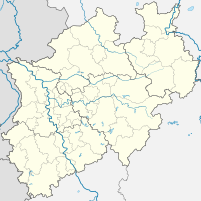Factory harbor Schwelgern
| Factory harbor Schwelgern | |||
|---|---|---|---|
| Data | |||
| owner | ThyssenKrupp | ||
| operator | Railroad and ports | ||
| start of building | 1903 | ||
| opening | 1907 | ||
| Port type | Inland port | ||
| Throughput | approx. 23,000,000 t | ||
| Geographic information | |||
| place | Hamborn | ||
| country | North Rhine-Westphalia | ||
| Country | Germany | ||
| In the foreground the Schwelgern factory harbor with the Schwelgern steelworks in the background on the left | |||
| Coordinates | 51 ° 30 '34 " N , 6 ° 43' 47" E | ||
|
|||
The factory port Schwelgern belongs to the north port of Walsum and the south port of Walsum to the three large private Duisburg coal and steel ports north of the Ruhr . It is one of the northernmost ports in the area of the city of Duisburg . The port in the Hamborn district on the Lower Rhine on the right bank of the Rhine near ( Rhine kilometer 790.20) today belongs to ThyssenKrupp as part of the railway and ports .
The port secures the import of raw materials for the blast furnaces and the coking plant of ThyssenKrupp Steel Europe . Ore , coal and aggregates are reloaded in Rotterdam from sea to inland vessels that bring the goods to Duisburg. Every year around 10,000 push barges with coal and ore, coupled in 4 and 6-person push convoy units, reach the port. The handling volume is 23 million tons. ThyssenKrupp Steel thus contributes to a large extent to the total handling of the ports in Duisburg, the location of the largest inland port in Europe.
history
Since Thyssen was only able to acquire ore concessions abroad , this promoted the internationalization of the group immediately before the First World War , which had been strongly export-oriented since the steel and rolling mills went into operation .
Since 1905 the Thyssen Group has built up its own trading and shipping network with branches all over the world. In order to meet the increased ore demand of the Bruckhausen and Meiderich blast furnaces cost-effectively across the Rhine to the plants, the first step was to build a new works port with modern loading facilities in Schwelgern to complement the previous works port in Alsum . In 1964, the factory harbor was expanded with a second port basin . After multiple rationalizations in the course of the 19th century, ship unloading bridges clear the ore almost automatically today. The port also serves the handling of bulk materials .
In 2003, a new coking plant was built in Schwelgern, from which the nearby Schwelgern blast furnaces are supplied with coke via conveyor belt systems.
Web links
Individual evidence
- ↑ a b c Schwelgern harbor: an important logistics hub on the Rhine handles 23 million tons per year - the factory harbor was extensively expanded 50 years ago , press release, Thyssen Krupp, July 15, 2014.
- ↑ Manfred Rasch, Gerald D. Feldmann (eds.): August Thyssen and Hugo Stinnes - Ein Briefwechsel 1898–1922 , series of publications for the journal for corporate history, Volume 10, Verlag CH Beck , ISBN 3 406 49637 7 .
- ↑ Schwelgern harbor , deutsche-leuchtfeuer.de.
- ↑ 50 years ago the port was expanded , series "Our Rhine" (episode 5), Rheinische Post , July 25, 2014.

